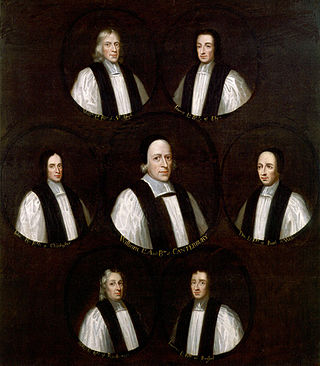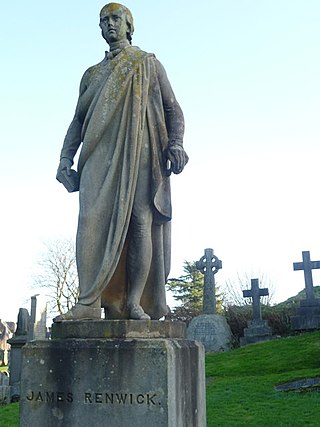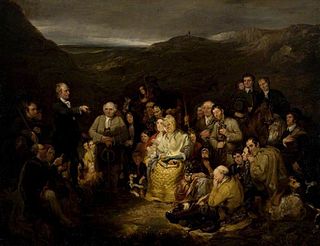Simony is the act of selling church offices and roles or sacred things. It is named after Simon Magus, who is described in the Acts of the Apostles as having offered two disciples of Jesus payment in exchange for their empowering him to impart the power of the Holy Spirit to anyone on whom he would place his hands. The term extends to other forms of trafficking for money in "spiritual things".

The Restoration of the Stuart monarchy in the kingdoms of England, Scotland, and Ireland took place in 1660 when King Charles II returned from exile in continental Europe. The preceding period of the Protectorate and the civil wars came to be known as the Interregnum (1649–1660).

The Act of Uniformity 1662 is an Act of the Parliament of England. It prescribed the form of public prayers, administration of sacraments, and other rites of the Established Church of England, according to the rites and ceremonies prescribed in the 1662 Book of Common Prayer. Adherence to this was required in order to hold any office in government or the church, although the new version of the Book of Common Prayer prescribed by the Act was so new that most people had never even seen a copy. The Act also required that the Book of Common Prayer "be truly and exactly Translated into the British or Welsh Tongue". It also explicitly required episcopal ordination for all ministers, i.e. deacons, priests and bishops, which had to be reintroduced since the Puritans had abolished many features of the Church during the Civil War. The act did not explicitly encompass the Isle of Man.

The Five Mile Act, or Oxford Act, or Nonconformists Act 1665, was an Act of the Parliament of England, passed in 1665 with the long title "An Act for restraining Non-Conformists from inhabiting in Corporations". It was one of the English penal laws that sought to enforce conformity to the established Church of England, and to expel any who did not conform. It forbade clergymen from living, visiting or preaching within five miles (8 km) of a parish from which they had been expelled, or to come within Five Miles of any city, town or borough that sends Members to Parliament unless they swore an oath never to resist the king, or attempt to alter the government of Church or State. The latter involved swearing to obey the 1662 prayer book. Thousands of ministers were deprived of a living under this act.
In English history, the penal laws were a series of laws that sought to uphold the establishment and State decreed religious monopoly of the Church of England against illegal and underground Catholics and Protestant nonconformists by imposing various forfeitures, civil penalties, and civil disabilities upon recusants from mandatory attendance at weekly Anglican Sunday services. The penal laws in general were repealed in the early 19th century during the process of Catholic Emancipation. Penal actions are civil in nature and were not English common law.

The Cavalier Parliament of England lasted from 8 May 1661 until 24 January 1679. It was the longest English Parliament, and longer than any Great British or UK Parliament to date, enduring for nearly 18 years of the quarter-century reign of Charles II of England. Like its predecessor, the Convention Parliament, it was overwhelmingly Royalist and is also known as the Pensioner Parliament for the many pensions it granted to adherents of the King.

Anthony Ashley Cooper, 1st Earl of Shaftesbury PC, FRS, was an English statesman and peer. He held senior political office under both the Commonwealth of England and Charles II, serving as Chancellor of the Exchequer from 1661 to 1672 and Lord Chancellor from 1672 to 1673. During the Exclusion Crisis, Shaftesbury headed the movement to bar the Catholic heir, James II, from the royal succession, which is often seen as the origin of the Whig party. He was also a patron of the political philosopher John Locke, with whom Shaftesbury collaborated with in writing the Fundamental Constitutions of Carolina in 1669.
Sedition is overt conduct, such as speech or organization, that tends toward rebellion against the established order. Sedition often includes subversion of a constitution and incitement of discontent toward, or insurrection against, established authority. Sedition may include any commotion, though not aimed at direct and open violence against the laws. Seditious words in writing are seditious libel. A seditionist is one who engages in or promotes the interest of sedition.

The Seven Bishops were members of the Church of England tried and acquitted for seditious libel in the Court of Kings Bench in June 1688. The very unpopular prosecution of the bishops is viewed as a significant event contributing to the November 1688 Glorious Revolution and deposition of James II.
Misprision of treason is an offence found in many common law jurisdictions around the world, having been inherited from English law. It is committed by someone who knows a treason is being or is about to be committed but does not report it to a proper authority.
Seditious libel is a criminal offence under common law of printing written material with seditious purpose – that is, the purpose of bringing contempt upon a political authority. It remains an offence in Canada but has been abolished in England and Wales.

The Killing Time was a period of conflict in Scottish history between the Presbyterian Covenanter movement, based largely in the southwest of the country, and the government forces of Kings Charles II and James VII. The period, roughly from 1679 to the Glorious Revolution of 1688, was subsequently called The Killing Time by Robert Wodrow in his The History of the Sufferings of the Church of Scotland from the Restoration to the Revolution, published in 1721–22. It is an important episode in the martyrology of the Church of Scotland.

Bushel’s Case (1670) 124 E.R. 1006, also spelled Bushell's Case, is a famous English decision on the role of juries. It established beyond question the independence of the jury. It also confirmed that the Court of Common Pleas could issue a writ of habeas corpus in ordinary criminal cases.

The Conventicles Act 1670 is an Act of the Parliament of England with the long title "An Act to prevent and suppress Seditious Conventicles".

A conventicle originally signified no more than an assembly and was frequently used by ancient writers for a church. At a semantic level conventicle is a Latinized synonym of the Greek word for church, and points to Jesus' promise in Matthew 18:20, "Where two or three are met together in my name."

The Religion Act 1592 or the Seditious Sectaries Act 1592 or the Act Against Puritans 1592 or the Conventicle Act 1593 was an Act of the Parliament of England. The Act imprisoned without bail those over the age of sixteen who failed to attend Church; persuaded others to do the same; denied Queen Elizabeth I's authority in religious matters; and who attended unlawful religious meetings. The Act was cognisable in the Court of High Commission. If, after offending, they did not conform in the next three months, they would be exiled from England forever. The Act fined those who harboured recusants £10 for every month hidden. The Act stated that it would continue no longer than the end of the next session of Parliament. However, the Act was still in effect in 1661, when John Bunyan was tried and convicted for disobedience to it.

From 1649 to 1660, Puritans in the Commonwealth of England were allied to the state power held by the military regime, headed by Lord Protector Oliver Cromwell until he died in 1658. They broke into numerous sects, of which the Presbyterian group comprised most of the clergy, but was deficient in political power since Cromwell's sympathies were with the Independents. During this period, the term "Puritan" becomes largely moot, therefore, in British terms, though the situation in New England was very different. After the English Restoration, the Savoy Conference and Uniformity Act 1662 and Great Ejection drove most of the Puritan ministers from the Church of England, and the outlines of the Puritan movement changed over a few decades into the collections of Presbyterian and Congregational churches, operating as they could as Dissenters under changing regimes.

The Restoration was the return of the monarchy to Scotland in 1660 after the period of the Commonwealth, and the subsequent three decades of Scottish history until the Revolution and Convention of Estates of 1689. It was part of a wider Restoration in the British Isles that included the return of the Stuart dynasty to the thrones of England and Ireland in the person of Charles II.

The Toleration Act 1689, also referred to as the Act of Toleration, was an Act of the Parliament of England. Passed in the aftermath of the Glorious Revolution, it received royal assent on 24 May 1689.

The Reformed Presbyterian Global Alliance is a communion of Presbyterians originating in Scotland in 1690 when its members refused to conform to the establishment of the Church of Scotland. The Reformed Presbyterian churches collectively have approximately 9,500 members worldwide in Northern Ireland, the Republic of Ireland, Scotland, France, the United States of America, Canada, Japan, South Sudan, and Australia.














